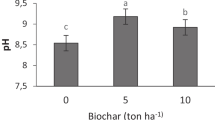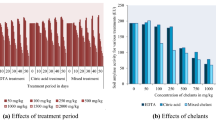Abstract
Purpose
Phytoremediation is the most sustainable and economical strategy for reclamation of the salt-affected soils. In order to investigate the relationship between phytoremediation and rhizosphere acidification, two experiments (greenhouse and field) were conducted using two acacia species viz. Acacia ampliceps and Acacia nilotica.
Materials and methods
In greenhouse experiment, both the species were exposed to 100 and 200 mM NaCl concentrations in solution culture. The release of organic acids from plant roots was determined after 14 and 28 days of the salt treatment. Shoot and root ash alkalinity was determined after harvesting the plants. In field experiment, both the species were grown on a saline sodic soil for 2 years. After every 6 months, plant growth data were recorded and soil samples were collected from different soil depths for physicochemical analyses.
Results and discussion
The results of greenhouse study indicated higher rhizosphere acidification by A. ampliceps than A. nilotica in terms of release of citric acid, malic acid, and tartaric acid along with ash alkalinity. The comparison of both the species in the field indicated higher amelioration in the soil properties like pHs, ECe, SAR, bulk density, and infiltration rate by A. ampliceps than A. nilotica.
Conclusions
It is concluded from these studies that A. ampliceps is more suitable species than A. nilotica for the phytoremediation of the salt-affected soils due to its higher rhizosphere acidification potential.




Similar content being viewed by others
References
Abbas G, Saqib M, Akhtar J, Basra SMA (2013) Salinity tolerance potential of two acacia species at early seedling stage. Pak J Agric Sci 50:683–688
Akhter J, Murray R, Mahmood K, Malik KA, Ahmed S (2004) Improvement of degraded physical properties of a saline-sodic soil by reclamation with kallar grass (Leptochloa fusca). Plant Soil 258:207–216
Arshad M, Silvestre J, Pinelli E, Kallerhoff J, Kaemmerer M, Tarigo A, Shahid M, Guiresse M, Pradere P, Dumat C (2008) A field study of lead phytoextraction by various scented Pelargonium cultivars. Chemosphere 71:2187–2192
Ashraf MY, Shirazi MU, Ashraf M, Sarwar G, Khan MA (2008) Utilization of salt-affected soils by growing some acacia species. In: Khan MA, Weber DJ (eds) Ecophysiology of high salinity tolerant plants. Springer Science + Business Media, pp 289–311
Austruy A, Shahid M, Xiong T, Castrec M, Payre V, Niazi NK, Sabir M, Dumat C (2014) Mechanisms of metal-phosphates formation in the rhizosphere soils of pea and tomato: environmental and sanitary consequences. J Soils Sediments 14:666–678
Basavaraja PK, Sharma SD, Dhananjaya BN, Badrinath MS (2011) Acacia nilotica: a tree species for amelioration of sodic soils in Central dry zone of Karnataka, India. Res J Agric Sci 2:311–316
Bouyoucos GJ (1962) Hydrometer method improved for making particle size analysis. J Agron 53:464–465
Chen JH, Lin YH (2010) Sodium chloride causes variation in organic acids and proteins in tomato root. Afr J Biotechnol 9:8161–8167
Dear BS, Virgona JM, Sandral GA, Swan AD, Morris B (2009) Changes in soil mineral nitrogen, nitrogen leached, and surface pH under annual and perennial pasture species. Crop Pasture Sci 69:975–986
Fang Z, An Z, Li Y (2008) Dynamic change of organic acids secreted from wheat roots in Mn deficiency. Front Agric China 2:50–54
Haigang L, Zhang F, Rengel Z, Shen J (2013) Rhizosphere properties in monocropping and intercropping systems between faba bean (Vicia faba L.) and maize (Zea mays L.) grown in a calcareous soil. Crop Pastor Sci 64:976–984
Ilyas M, Miller RW, Qureshi RH (1993) Hydraulic conductivity of saline-sodic soil after gypsum application and cropping. Soils Sci Soc Am J 57:1580–1585
Jackson ML (1962) Soil chemical analysis. Prentice-Hall, Inc., Englewood Cliffs, NS
Jungk A (1968) Die Alkalinitaet der Pflanzenasche als Maß fue r den Kationenueberschuß in der Pflanze. Z Pflanzenernähr Bodenkd 120:99–105
Kaur B, Gupta SR, Singh G (2002) Bioamelioration of a sodic soil by silvopastoral systems in northwestern India. Agrofor Syst 54:13–20
Klute A (1986) Methods of soil analysis. Part 1, Agronomy 9. Soil Science Society of America, Madison
Larsen PB, Degenhardt J, Tai CY, Stenzler LM, Howell SH, Kochain LV (1998) Aluminum-resistant arabidopsis mutants that exhibit altered patterns of aluminum accumulation and organic acid release from roots. Plant Physiol 117:9–18
Martin BC, George SJ, Price CA, Ryan MH, Tibbett M (2014) The role of root exuded low molecular weight organic anions in facilitating petroleum hydrocarbon degradation: current knowledge and future directions. Sci Total Environ 472:642–653
Mishra A, Sharma SD (2003) Leguminous trees for the restoration of degraded sodic wasteland in the eastern Uttar Pradesh, India. Land Degrad Dev 14:245–261
Moody PW, Aitken RL (1997) Soil acidification under some tropical agricultural systems: I. Rates of acidification and contributing factors. Aust J Soils Res 35:163–173
Munns R, Tester M (2008) Mechanisms of salinity tolerance. Ann Rev Plant Biol 59:651–681
Oster JD, Shainberg I, Abrol IP (1999) Reclamation of salt affected soils. In: Skaggs RW, Schilfgaarde JV (eds) Agricultural drainage. ASA-CSSA-SSSA, Madison, WI, pp 659–691
Qadir M, Oster JD (2004) Crop and irrigation management strategies for saline sodic soils and waters aimed at environmentally sustainable agriculture. Sci Total Environ 323:1–19
Qadir M, Qureshi RH, Ahmad N (1996) Reclamation of a saline-sodic soil by gypsum and Leptochloa fusca. Geoderma 74:207–217
Qadir M, Qureshi RH, Ahmad N (1997) Nutrient availability in a calcareous saline-sodic soil during vegetative bioremediation. Arid Soils Res Rehabil 11:343–352
Qadir M, Steffens D, Yan F, Schubert S (2003a) Proton release by N2-fixing plant roots: a possible contribution to phytoremediation of calcareous sodic soils. J Plant Nutr Soils Sci 166:14–22
Qadir M, Steffens D, Yan F, Schubert S (2003b) Sodium removal from a calcareous saline-sodic soil through leaching and plant uptake during phytoremediation. Land Degrad Dev 14:301–307
Qadir M, Noble AD, Schubert S, Thomas RJ, Arslan A (2006) Sodicity induced land degradation and its sustainable management: problems and prospects. Land Degrad Dev 17:661–676
Qadir M, Oster JD, Schubert S, Noble AD, Sahrawat KL (2007) Phytoremediation of sodic and saline-sodic soils. Adv Agron 96:197–247
Quirk JP (2001) The significance of the threshold and turbidity concentrations in relation to sodicity and microstructure. Aust J Soils Sci 39:1185–1217
Qureshi RH, Barrett-Lennard EG (1998) Saline agriculture for irrigated land in Pakistan: a handbook. Australian Centre for International Agricultural Research Canberra, Australia
Richard LA (1954) Diagnosis and improvement of saline and alkali soils. USDA Handbook 60, Washington, DC, pp. 160
Saqib M, Akhtar J, Abbas G, Nasim M (2013) Salinity and drought interaction in wheat (Triticum aestivum L.) is affected by the genotype and plant growth stage. Acta Physiol Plant 35:2761–2768
Schubert E, Schubert S, Mengel K (1990a) Soil pH and calcium fixation and growth of broad bean. Agron J 82:969–972
Schubert E, Schubert S, Mengel K (1990b) Effect of low pH of the root medium on proton release, growth, and nutrient uptake of field beans (Vicia faba). Plant Soils 124:239–244
Shahid M, Arshad M, Kaemmerer M, Pinelli E, Probst A, Baque D, Pradere P, Dumat C (2012a) Long-term field metal extraction by Pelargonium: phytoextraction efficiency in relation to plant maturity. Int J Phytorem 14:493–505
Shahid M, Pinelli E, Dumat C (2012b) Review of Pb availability and toxicity to plants in relation with metal speciation; role of synthetic and natural organic ligands. J Hazard Mater 219–220:1–12
Shahid M, Xiong T, Masood N, Leveque T, Quenea K, Austruy A, Foucault Y, Dumat C (2014) Influence of plant species and phosphorus amendments on metal speciation and bioavailability in a smelter impacted soil: a case study of food-chain contamination. J Soils Sediments 14:655–665
Steel RGD, Torrie JH, Dickey DA (1997) Principles and procedures of statistics: a biometrical approach, 3rd edn. McGraw Hill Co, New York, USA
Tang C, Weligama C, Sale P (2013) Subsurface soil acidification: its possible causes and management options. In: Xu JM, Sparks D (eds) Molecular environmental soil science at critical zone interfaces. Springer, Dordrecht, pp 389–412
Acknowledgments
The authors gratefully acknowledge the financial and technical support provided by the Endowment Fund Secretariat, University of Agriculture, Faisalabad, Pakistan.
Author information
Authors and Affiliations
Corresponding author
Additional information
Responsible editor: Caixian Tang
Rights and permissions
About this article
Cite this article
Abbas, G., Saqib, M., Akhtar, J. et al. Relationship between rhizosphere acidification and phytoremediation in two acacia species. J Soils Sediments 16, 1392–1399 (2016). https://doi.org/10.1007/s11368-014-1051-9
Received:
Accepted:
Published:
Issue Date:
DOI: https://doi.org/10.1007/s11368-014-1051-9




